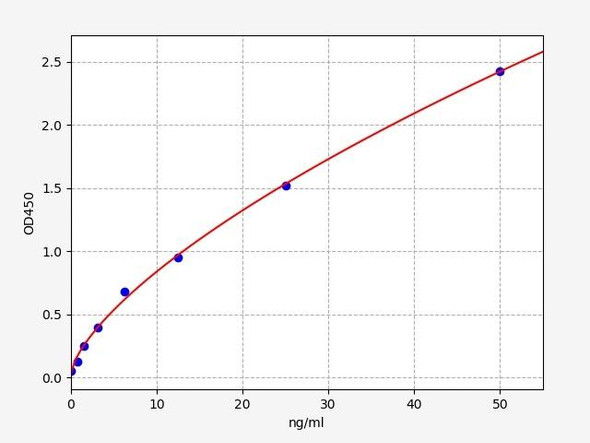Rat Cytochrome P450 1B1 (Cyp1b1) ELISA Kit
- SKU:
- RTEB0554
- Product Type:
- ELISA Kit
- Size:
- 96 Assays
- Uniprot:
- Q64678
- Range:
- 0.625-40 ng/mL
- ELISA Type:
- Sandwich
- Synonyms:
- Cyp1b1, Cytochrome P450, family 1, subfamily B, polypeptide 1, Cytochrome P450RAP
- Reactivity:
- Rat
Description
| Product Name: | Rat Cytochrome P450 1B1 (Cyp1b1) ELISA Kit |
| Product Code: | RTEB0554 |
| Alias: | Cytochrome P450 1B1, CYPIB1, Cytochrome P450RAP, Cyp1b1, 1.14.14.1 |
| Uniprot: | Q64678 |
| Reactivity: | Rat |
| Range: | 0.625-40 ng/mL |
| Detection Method: | Sandwich |
| Size: | 96 Assay |
| Storage: | Please see kit components below for exact storage details |
| Note: | For research use only |
| UniProt Protein Function: | CYP1B1: Cytochromes P450 are a group of heme-thiolate monooxygenases. In liver microsomes, this enzyme is involved in an NADPH-dependent electron transport pathway. It oxidizes a variety of structurally unrelated compounds, including steroids, fatty acids, and xenobiotics. Defects in CYP1B1 are the cause of primary congenital glaucoma type 3A (GLC3A). GLC3A is an autosomal recessive form of primary congenital glaucoma (PCG). PCG is characterized by marked increase of intraocular pressure at birth or early childhood, large ocular globes (buphthalmos) and corneal edema. It results from developmental defects of the trabecular meshwork and anterior chamber angle of the eye that prevent adequate drainage of aqueous humor. Defects in CYP1B1 are a cause of primary open angle glaucoma (POAG). POAG is a complex and genetically heterogeneous ocular disorder characterized by a specific pattern of optic nerve and visual field defects. The angle of the anterior chamber of the eye is open, and usually the intraocular pressure is increased. The disease is asymptomatic until the late stages, by which time significant and irreversible optic nerve damage has already taken place. In some cases, POAG shows digenic inheritance involving mutations in CYP1B1 and MYOC genes. Defects in CYP1B1 are a cause of Peters anomaly (PAN). Peters anomaly is a congenital defect of the anterior chamber of the eye. Belongs to the cytochrome P450 family. |
| UniProt Protein Details: | Protein type:Motility/polarity/chemotaxis; Oxidoreductase; Membrane protein, peripheral; Endoplasmic reticulum; Amino Acid Metabolism - tryptophan; EC 1.14.14.1; Xenobiotic Metabolism - metabolism by cytochrome P450 Cellular Component: endoplasmic reticulum membrane; integral to membrane; intracellular membrane-bound organelle; mitochondrion; nucleus Molecular Function:heme binding; iron ion binding; monooxygenase activity; oxidoreductase activity; oxidoreductase activity, acting on paired donors, with incorporation or reduction of molecular oxygen; oxidoreductase activity, acting on paired donors, with incorporation or reduction of molecular oxygen, reduced flavin or flavoprotein as one donor, and incorporation of one atom of oxygen Biological Process: adrenal gland development; angiogenesis; arachidonic acid metabolic process; aromatic compound metabolic process; benzene and derivative metabolic process; blood vessel morphogenesis; cell adhesion; collagen fibril organization; dibenzo-p-dioxin metabolic process; DNA modification; endothelial cell migration; estrogen metabolic process; induction of apoptosis by oxidative stress; inhibition of NF-kappaB transcription factor; male gonad development; membrane lipid catabolic process; negative regulation of cell adhesion mediated by integrin; negative regulation of cell migration; negative regulation of cell proliferation; nitric oxide biosynthetic process; positive regulation of angiogenesis; positive regulation of apoptosis; positive regulation of JAK-STAT cascade; positive regulation of smooth muscle cell migration; positive regulation of translation; response to arsenic; response to estradiol stimulus; response to follicle-stimulating hormone stimulus; response to nutrient; response to organic cyclic substance; response to organic substance; response to steroid hormone stimulus; response to toxin; retinal metabolic process; retinol metabolic process; steroid metabolic process; toxin metabolic process; xenobiotic metabolic process |
| NCBI Summary: | plays a role in polycyclic aromatic hydrocarbon metabolism in adrenal microsomes [RGD, Feb 2006] |
| UniProt Code: | Q64678 |
| NCBI GenInfo Identifier: | 6978737 |
| NCBI Gene ID: | 25426 |
| NCBI Accession: | NP_037072.1 |
| UniProt Related Accession: | Q64678 |
| Molecular Weight: | 61.9 kDa |
| NCBI Full Name: | cytochrome P450 1B1 |
| NCBI Synonym Full Names: | cytochrome P450, family 1, subfamily b, polypeptide 1 |
| NCBI Official Symbol: | Cyp1b1 |
| NCBI Protein Information: | cytochrome P450 1B1 |
| UniProt Protein Name: | Cytochrome P450 1B1 |
| UniProt Synonym Protein Names: | CYPIB1; Cytochrome P450RAP |
| Protein Family: | Cytochrome |
| UniProt Gene Name: | Cyp1b1 |
| UniProt Entry Name: | CP1B1_RAT |
| Component | Quantity (96 Assays) | Storage |
| ELISA Microplate (Dismountable) | 8×12 strips | -20°C |
| Lyophilized Standard | 2 | -20°C |
| Sample Diluent | 20ml | -20°C |
| Assay Diluent A | 10mL | -20°C |
| Assay Diluent B | 10mL | -20°C |
| Detection Reagent A | 120µL | -20°C |
| Detection Reagent B | 120µL | -20°C |
| Wash Buffer | 30mL | 4°C |
| Substrate | 10mL | 4°C |
| Stop Solution | 10mL | 4°C |
| Plate Sealer | 5 | - |
Other materials and equipment required:
- Microplate reader with 450 nm wavelength filter
- Multichannel Pipette, Pipette, microcentrifuge tubes and disposable pipette tips
- Incubator
- Deionized or distilled water
- Absorbent paper
- Buffer resevoir
*Note: The below protocol is a sample protocol. Protocols are specific to each batch/lot. For the correct instructions please follow the protocol included in your kit.
Allow all reagents to reach room temperature (Please do not dissolve the reagents at 37°C directly). All the reagents should be mixed thoroughly by gently swirling before pipetting. Avoid foaming. Keep appropriate numbers of strips for 1 experiment and remove extra strips from microtiter plate. Removed strips should be resealed and stored at -20°C until the kits expiry date. Prepare all reagents, working standards and samples as directed in the previous sections. Please predict the concentration before assaying. If values for these are not within the range of the standard curve, users must determine the optimal sample dilutions for their experiments. We recommend running all samples in duplicate.
| Step | |
| 1. | Add Sample: Add 100µL of Standard, Blank, or Sample per well. The blank well is added with Sample diluent. Solutions are added to the bottom of micro ELISA plate well, avoid inside wall touching and foaming as possible. Mix it gently. Cover the plate with sealer we provided. Incubate for 120 minutes at 37°C. |
| 2. | Remove the liquid from each well, don't wash. Add 100µL of Detection Reagent A working solution to each well. Cover with the Plate sealer. Gently tap the plate to ensure thorough mixing. Incubate for 1 hour at 37°C. Note: if Detection Reagent A appears cloudy warm to room temperature until solution is uniform. |
| 3. | Aspirate each well and wash, repeating the process three times. Wash by filling each well with Wash Buffer (approximately 400µL) (a squirt bottle, multi-channel pipette,manifold dispenser or automated washer are needed). Complete removal of liquid at each step is essential. After the last wash, completely remove remaining Wash Buffer by aspirating or decanting. Invert the plate and pat it against thick clean absorbent paper. |
| 4. | Add 100µL of Detection Reagent B working solution to each well. Cover with the Plate sealer. Incubate for 60 minutes at 37°C. |
| 5. | Repeat the wash process for five times as conducted in step 3. |
| 6. | Add 90µL of Substrate Solution to each well. Cover with a new Plate sealer and incubate for 10-20 minutes at 37°C. Protect the plate from light. The reaction time can be shortened or extended according to the actual color change, but this should not exceed more than 30 minutes. When apparent gradient appears in standard wells, user should terminatethe reaction. |
| 7. | Add 50µL of Stop Solution to each well. If color change does not appear uniform, gently tap the plate to ensure thorough mixing. |
| 8. | Determine the optical density (OD value) of each well at once, using a micro-plate reader set to 450 nm. User should open the micro-plate reader in advance, preheat the instrument, and set the testing parameters. |
| 9. | After experiment, store all reagents according to the specified storage temperature respectively until their expiry. |
When carrying out an ELISA assay it is important to prepare your samples in order to achieve the best possible results. Below we have a list of procedures for the preparation of samples for different sample types.
| Sample Type | Protocol |
| Serum | If using serum separator tubes, allow samples to clot for 30 minutes at room temperature. Centrifuge for 10 minutes at 1,000x g. Collect the serum fraction and assay promptly or aliquot and store the samples at -80°C. Avoid multiple freeze-thaw cycles. If serum separator tubes are not being used, allow samples to clot overnight at 2-8°C. Centrifuge for 10 minutes at 1,000x g. Remove serum and assay promptly or aliquot and store the samples at -80°C. Avoid multiple freeze-thaw cycles. |
| Plasma | Collect plasma using EDTA or heparin as an anticoagulant. Centrifuge samples at 4°C for 15 mins at 1000 × g within 30 mins of collection. Collect the plasma fraction and assay promptly or aliquot and store the samples at -80°C. Avoid multiple freeze-thaw cycles. Note: Over haemolysed samples are not suitable for use with this kit. |
| Urine & Cerebrospinal Fluid | Collect the urine (mid-stream) in a sterile container, centrifuge for 20 mins at 2000-3000 rpm. Remove supernatant and assay immediately. If any precipitation is detected, repeat the centrifugation step. A similar protocol can be used for cerebrospinal fluid. |
| Cell culture supernatant | Collect the cell culture media by pipette, followed by centrifugation at 4°C for 20 mins at 1500 rpm. Collect the clear supernatant and assay immediately. |
| Cell lysates | Solubilize cells in lysis buffer and allow to sit on ice for 30 minutes. Centrifuge tubes at 14,000 x g for 5 minutes to remove insoluble material. Aliquot the supernatant into a new tube and discard the remaining whole cell extract. Quantify total protein concentration using a total protein assay. Assay immediately or aliquot and store at ≤ -20 °C. |
| Tissue homogenates | The preparation of tissue homogenates will vary depending upon tissue type. Rinse tissue with 1X PBS to remove excess blood & homogenize in 20ml of 1X PBS (including protease inhibitors) and store overnight at ≤ -20°C. Two freeze-thaw cycles are required to break the cell membranes. To further disrupt the cell membranes you can sonicate the samples. Centrifuge homogenates for 5 mins at 5000xg. Remove the supernatant and assay immediately or aliquot and store at -20°C or -80°C. |
| Tissue lysates | Rinse tissue with PBS, cut into 1-2 mm pieces, and homogenize with a tissue homogenizer in PBS. Add an equal volume of RIPA buffer containing protease inhibitors and lyse tissues at room temperature for 30 minutes with gentle agitation. Centrifuge to remove debris. Quantify total protein concentration using a total protein assay. Assay immediately or aliquot and store at ≤ -20 °C. |
| Breast Milk | Collect milk samples and centrifuge at 10,000 x g for 60 min at 4°C. Aliquot the supernatant and assay. For long term use, store samples at -80°C. Minimize freeze/thaw cycles. |










